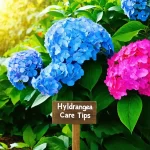Green hydrangeas, with their striking hues, offer a unique twist to traditional floral displays. While many are familiar with hydrangeas in shades of blue, pink, and white, green hydrangeas have surged in popularity for their elegance and versatility in garden design. The spectrum of green hydrangeas ranges from vibrant lime to soft green, and can evolve into creamy white or even pink as the blooms mature, making them a stunning addition to any landscape.
Why Are My Hydrangeas Turning Green?
One question that many gardeners grapple with is why their hydrangeas are turning green. While this transformation can be surprising, it’s essential to understand that several factors contribute to this color change. In most cases, the transformation from anOther color, like blue or pink, to green is influenced by environmental conditions, the variety of hydrangea, and the aging process of the blooms.
Common Reasons Hydrangeas Turn Green
Here are some reasons why hydrangeas may take on a green appearance:
- Environmental Stress: Weather conditions such as excessive rain or drought can lead to changes in color.
- Aging Blooms: As hydrangea flowers mature, they may fade to a greenish hue, which is completely natural.
- Soil pH: The acidity or alkalinity of the soil can impact the flower’s color, particularly in varieties that typically show blue or pink hues.
Popular Green Hydrangea Varieties
| Hydrangea Variety | Description | Bloom Time | Growth Height | Hardiness Zones |
|---|---|---|---|---|
| Limelight | Iconic for its large, lime-green blooms that transition to creamy white and blush tones. | July to September | 6 to 8 feet | 3a to 9a |
| Pistachio | Offers a unique blend of green and pink hues, creating a visual spectacle in any garden. | June to August | 4 to 5 feet | 4a to 9b |
| Bobo | A compact hydrangea with abundant, soft green blooms that last well into the fall. | June to September | 3 to 4 feet | 3b to 8 |
| Invincibelle Limetta | Notable for its sturdy stems and striking lime green flowers, perfect for cut arrangements. | June to September | 3 to 4 feet | 3 to 9 |

The Lifecycle of Green Hydrangeas
Green hydrangeas are not just a seasonal wonder; they follow a fascinating lifecycle that influences their appearance throughout the year:
- Spring Awakening: As the weather warms, these plants emerge with rich green foliage, preparing for bloom.
- Summer Bloom: During the peak of summer, the blooms begin to show their initial vibrant colors, often starting as deep green.
- Autumn Transition: With cooler temperatures and shortening days, green hydrangeas can transition into softer shades, including whites and pinks.
- Winter Dormancy: Following the bloom cycle, the plants enter dormancy, often losing their leaves but maintaining their structural beauty.
Care Tips for Green Hydrangeas
To ensure your green hydrangeas flourish, follow these essential care tips:
- Watering: Hydrangeas prefer moist, well-drained soil. Water them deeply during dry spells to promote healthy growth.
- Fertilizing: Use a balanced, slow-release fertilizer in early spring to support blooming.
- Pruning: Depending on the variety, prune after flowering to shape the bush and encourage new growth.
- Sunlight: Most hydrangeas thrive in partial shade. Ensure they receive morning sun with protection from harsh afternoon rays.
Reference Video
FAQs About Green Hydrangeas
1. Why do hydrangeas turn green as they bloom?
Hydrangeas can turn green during the blooming process due to the natural aging of the flowers, environmental factors, or the shift in soil pH affecting pigment composition.
2. Can green hydrangeas be grown in containers?
Yes, varieties like ‘Limelight’ and ‘Bobo’ thrive in containers, making them versatile for patios or small gardens. Ensure containers have drainage holes and use quality potting soil.
3. How do I achieve different colors in my hydrangeas?
The flower color in some hydrangea species can change based on soil pH. Higher acidity tends to produce blue blooms, while alkaline conditions yield pink. Keep in mind that the green varieties have less variation in their color spectrum.
4. What pests commonly affect green hydrangeas?
Common pests include aphids, spider mites, and scales. Regular inspection and proper care can help manage infestations.
5. Are there any diseases that affect hydrangeas?
Hydrangeas can be susceptible to diseases like powdery mildew and root rot. Proper watering practices and choosing resistant varieties can mitigate these issues.
Unique Features and Trends
Green hydrangeas, including those that bloom in unusual green shades, are becoming increasingly popular in floral arrangements and garden design. Their unique coloration complements various landscaping themes, from modern minimalism to lush cottage gardens.
The Role of Green Hydrangeas in Landscaping
Green hydrangeas can serve multiple purposes in landscaping, including:
- Accent Plants: Perfect for adding a refreshing touch to flower beds or borders.
- Cut Flowers: Ideal for bouquets and floral displays due to their longer-lasting blooms once cut.
- Seasonal Interest: They provide visual interest year-round, transitioning through various shades from spring through winter.

For those looking to explore further into the captivating world of green hydrangeas, consider checking out detailed resources that dive deeper into their care and varieties, such as Epic Gardening and Gardening Know How.
In conclusion, green hydrangeas have much to offer beyond their distinctive color. By understanding their characteristics and care requirements, gardeners can enjoy a striking, versatile flower that brightens any space.


